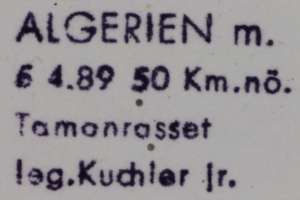2. Diagnose
2.1. Männchen
2.2. Weibchen
2.3. Erstbeschreibung
3. Weitere Informationen
3.1. Andere Kombinationen
- Palpangula hilgerti Rothschild, 1909 [Originalkombination]
3.2. Unterarten
- Anumeta hilgerti popovi Wiltshire, 1982
3.3. Faunistik
Kravchenko et al. (2004: 180) schreiben zur Verbreitung der Art: "Afro-Eremic. Widespread in the deserts of North Africa. From Morocco to the Arabian Peninsula. In Israel: represented by the ssp. popovi Wiltshire, 1982. In sandy areas in the southern part of the Arava Valley. Locally common." Kravchenko et al. (2015: 13) führen die Art für den Süden von Jordanien an.
Nach Fibiger et al. (2006: 199) kommt die Art auch auf Malta vor: "Material. Malta, ♂ Pembroke 10. vi. 1991, leg. Catania. (AC), prep. Fibiger 5175; ♀ same data (AC)." Die Art war daher in die Europaliste aufzunehmen. Die Autoren erläutern: "A. hilgerti is illustrated by Sammut (2000: fig. 316) as Anumeta cestis (Ménétriés, 1848). However, A. cestis occurs neither in Europe nor on Malta. It occurs in South East European Russia, e.g. the dunes by the northern Caspian Sea (Goater et al. 2003). A. hilgerti is described from Algeria, southern Sahara, Bdj. Ferdjan, where it occurs sympatrically with A. cestis. It is a Saharo-Arabian species, distributed throughout the desert zone of North Africa from Morocco to Egypt and all of the Arabian Peninsula (Rungs 1981; Wiltshire 1990). In the European list (Fibiger & Hacker, 2005) it should be placed after Anumeta cestis (Ménétriés, 1848). New record to the fauna of Malta and Europe."
Nach der [Fauna Europaea] kommt A. hilgerti auch auf den Kanarischen Inseln vor.
(Autor: Erwin Rennwald)
3.4. Literatur
- Fibiger, M., Sammut, P., Seguna, A., Catania, A. (2006): Recent records of Noctuidae from Malta, with five species new to the European fauna, and a new subspecies. — Nota lepidopterologica 29 (3/4): 193-213 [Digitalisat auf archive.org].
- Kravchenko, V.D., Müller, G., Orlova, O.B. & V.N. Seplyarskaya (2004): The Catocalinae (Lepidoptera: Noctuidae) of Israel. - Russian Entomological Journal, 13 (3): 175–186. [PDF auf web.archive.org]
- Kravchenko, V.D., Mooser, J., Speidel, W., Revay, E., Witt, T. & G.C. Müller (2015): An annotated checklist of the Noctuoidea of Jordan with remarks on ecology, phenology and zoogeography. Part I: Erebidae & Euteliidae (Lepidoptera: Noctuidae). - SHILAP Revista de lepidopterogía, 43 (169): 5-14. [PDF auf redalyc.org]
- Erstbeschreibung: Rothschild, W. (1909): Mauretanisches. — Entomologische Zeitschrift 23 (32): 142. Stuttgart.




![Vorkommen auf den Kanarischen Inseln [Vives Moreno, A. (2014)]](/res/img/flag/es-cn.png)

![Vorkommen in Jordanien [Kravchenko, Mooser, Speidel, Revay, Witt & Müller (2015)]](/res/img/flag/jo.gif)














